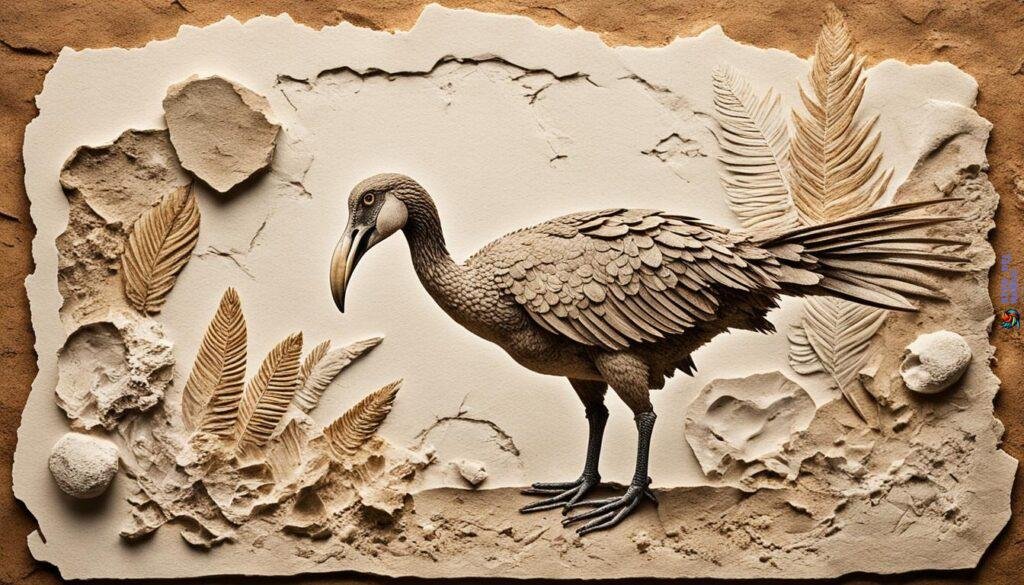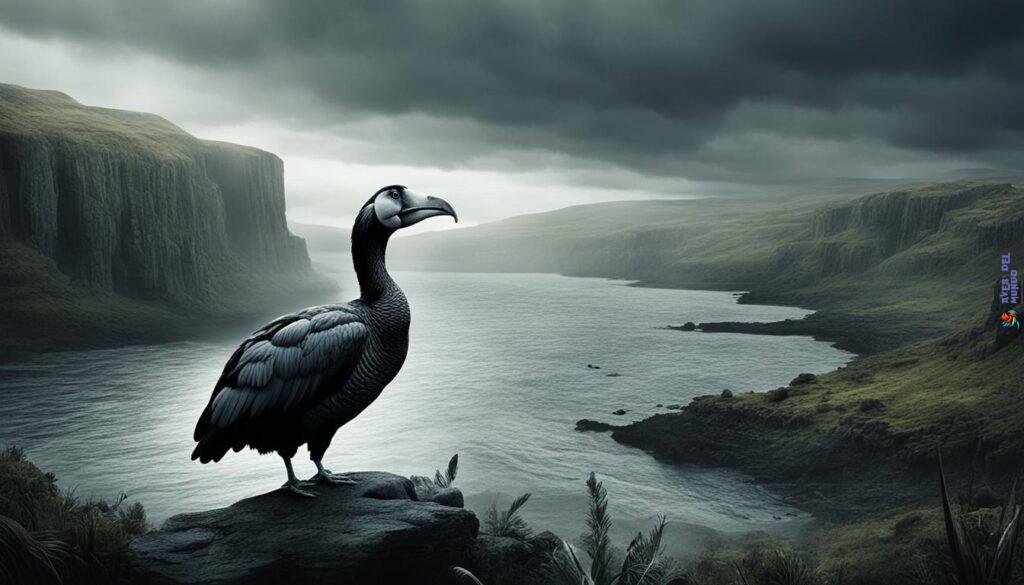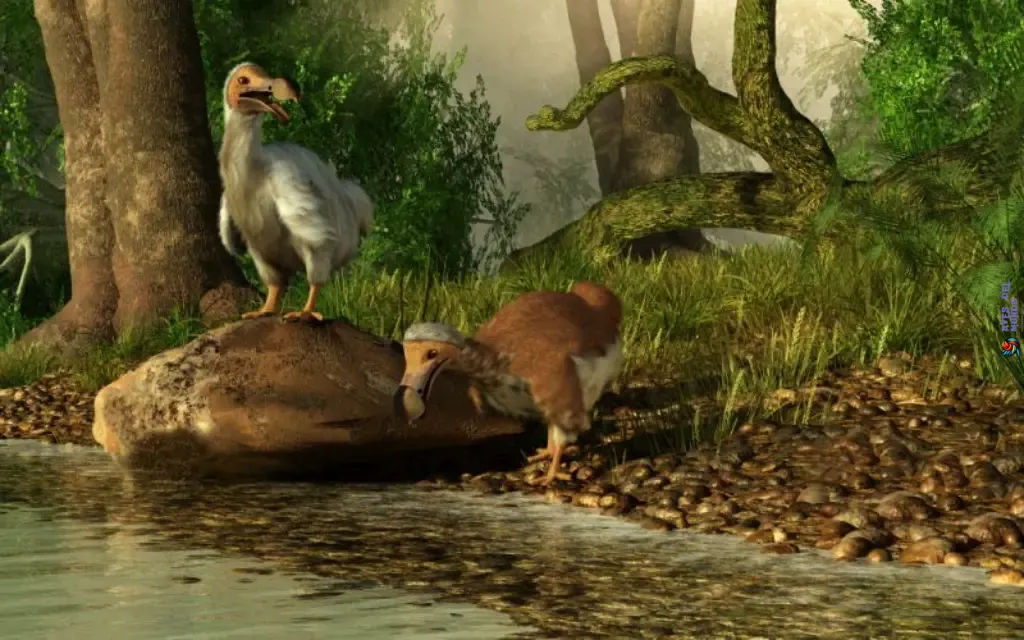Did you know that the dodo bird, a once-thriving avian species, is now extinct? This flightless bird, native to the remote island of Mauritius, captured the imagination of explorers and scientists alike. Today, the dodo remains a symbol of ancient mysteries, with its story encompassing crucial lessons about conservation efforts and the fragile balance of our ecosystem.
In this article, we will delve into the fascinating history and life of the dodo bird, examine the ecological factors that led to its extinction, and explore the valuable insights gained from fossil analysis and scientific research. Join us on this journey to uncover the secrets of the dodo and discover how its legacy continues to impact our world today.
The Life of the Dodo Bird
The Dodo Bird, native to Mauritius Island in the Indian Ocean, was once a remarkable species that faced extinction in the 17th century.
When Dutch sailors arrived on the island, they unknowingly introduced new organisms that disrupted the delicate balance of the ecosystem. This, combined with other factors including hunting, competition for food, and habitat destruction, ultimately led to the demise of the dodo bird.
This unique bird species, known for its flightlessness and distinct appearance, struggled to survive in the face of these challenges. As a result, the dodo bird became extinct, leaving behind a legacy of ecological significance and a cautionary tale about the consequences of human interactions with the natural world.

| Factors contributing to the extinction of the dodo bird |
|---|
| Hunting |
| Competition for food |
| Habitat destruction |
Insights from Fossil Analysis
Although complete dodo bird specimens no longer exist, fragments of bones and other remnants provide valuable insights into the bird’s anatomy, physiology, and evolutionary history. Scientific analysis of these fossils has helped researchers understand aspects such as the dodo’s biology, diet, and adaptations to its environment.
Studying the fossilized remains of the dodo bird has allowed scientists to reconstruct its anatomy with remarkable detail. Through careful examination of the bones, researchers have been able to piece together the bird’s skeletal structure and gain insights into its overall size and shape.

Furthermore, fossil evidence has revealed important information about the dodo’s physiology. By examining the internal structures of the bones, scientists have been able to deduce various aspects of the dodo’s biology, such as its growth patterns, reproductive processes, and even the presence of certain diseases or injuries.
The study of dodo bird fossils has also shed light on the bird’s diet. By analyzing the preserved stomach contents and dental remains, researchers have been able to determine that the dodo primarily fed on fruits and seeds. This information helps us understand the bird’s ecological role and its relationship with other plant species on the island.
Moreover, fossil analysis has provided crucial insights into the evolutionary history of the dodo bird. By comparing the dodo’s anatomy to that of its closest relatives, scientists have been able to trace its lineage and understand how it diverged from other bird species over time. This evolutionary perspective helps us comprehend the unique adaptations that allowed the dodo to thrive in its island habitat.
To summarize, although complete dodo bird specimens are no longer available, the discovery and analysis of fossils have provided invaluable information about the bird’s anatomy, physiology, diet, and evolution. Through careful examination and interpretation of these ancient remains, scientists have been able to piece together a more comprehensive understanding of the dodo’s existence and its place within the natural world.
The Extinction of the Dodo Bird
The extinction of the dodo bird is a tragic tale shaped by a complex interplay of ecological factors, human interactions, and the introduction of invasive species. Within a few decades of its discovery, this unique bird species faced complete annihilation due to the disturbance of nesting grounds and the depletion of its food sources.
Ecological factors played a significant role in the dodo bird’s extinction. Native to Mauritius Island, the dodo’s habitat was limited, making it vulnerable to changes in its environment. As human settlements expanded and land was cleared for agriculture and development, the dodo’s nesting grounds were disrupted, leading to a decline in the bird’s population.
Furthermore, the arrival of humans brought with it the introduction of invasive species to the island. Rats and other animals that accompanied sailors preyed on dodo eggs and chicks, further impacting the reproductive success and survival of the species. Additionally, the clearing of forests for agriculture and timber deprived the dodo of its natural habitat and food sources.
Human interactions played a devastating role in the dodo bird’s demise. The dodo had no natural fear of humans, which made it an easy target for hunting. Sailors and settlers exploited this vulnerability, hunting the dodos for food and sport, contributing to a rapid decline in their population.
The introduction of invasive species proved to be a tipping point for the dodo bird’s survival. The predators and competitors brought by humans disrupted the delicate balance of the island’s ecosystem, leaving the dodo bird with limited resources and increasing competition for food. Without its natural defenses against these new invaders, the dodo population rapidly declined, ultimately leading to its extinction.

Impact of Extinction
The extinction of the dodo bird had far-reaching consequences. This unique bird species played a crucial role in the island’s ecosystem, contributing to seed dispersal and plant regeneration. With the dodo’s extinction, the ecological dynamics of Mauritius Island changed, affecting the survival and distribution of other plant and animal species.
Furthermore, the loss of the dodo bird serves as a stark reminder of the fragile nature of Earth’s biodiversity and the impact of human actions on vulnerable species. It emphasizes the need for conservation efforts and responsible stewardship of our natural resources to prevent the loss of other invaluable creatures like the dodo.
Lessons for Conservation
The study of the Dodo Bird offers valuable lessons for modern conservation efforts. The vulnerability of isolated island species to external pressures is exemplified by the dodo’s fate. By examining the dodo’s interactions with its environment and the consequences of human impact, scientists gain insights into the complex dynamics between species, ecosystems, and the effects of introduced species.
1. Conservation Efforts:
Understanding the plight of the dodo bird highlights the importance of proactive conservation efforts. By implementing strategies to protect and preserve endangered species, we can mitigate the risk of future extinctions and safeguard the delicate balance of ecosystems.
2. Environmental Impact:
The dodo’s extinction serves as a stark reminder of how human activities can have a significant environmental impact. The introduction of invasive species, habitat destruction, and overhunting all contributed to the demise of this beautiful bird. By recognizing and minimizing our negative impact, we can pave the way for a more sustainable future.
3. Protecting Island Species:
The dodo bird’s fate emphasizes the unique challenges faced by island species. Isolated from mainland populations, these species are particularly susceptible to the introduction of new organisms and disruptions to their fragile habitats. By implementing rigorous biosecurity measures and conservation initiatives, we can help protect these vulnerable island ecosystems.
4. Managing Introduced Species:
The dodo’s extinction is a sobering example of the detrimental effects of introduced species. The introduction of pigs, rats, and other animals by human settlers drastically altered the dodo’s habitat and food sources, leading to its extinction. Recognizing the impacts of introduced species is vital for managing invasive species and preserving native biodiversity.
5. Collaborative Conservation:
The story of the dodo bird reminds us of the importance of collaboration in conservation efforts. Scientists, policymakers, communities, and individuals must work together to develop and implement effective conservation strategies. Through collective action, we can make a positive and lasting impact on the preservation of our planet’s precious species.

Rediscovering the Dodo Bird
Scientists are employing innovative techniques to shed light on the dodo bird’s fascinating world. Through the creation of virtual 3D models based on the existing dodo bird specimens, researchers aim to understand the bird’s anatomy, proportions, and movements. This cutting-edge research allows for accurate measurements and has the potential to revolutionize our understanding of the dodo’s unique lifestyle.
By using virtual 3D models, scientists can closely examine the dodo bird’s skeletal structure and internal organs, providing valuable insights into its anatomy. These models enable researchers to analyze the intricate details of the dodo’s bones and estimate its size and proportions accurately.
Furthermore, the virtual 3D models open up new avenues for studying the dodo bird’s movements. By digitally reconstructing its musculature, scientists can simulate the dodo’s range of motion and gain insight into its behaviors. This advanced technology offers a glimpse into the dodo’s natural habitat and how it interacted with its surroundings.
Preserving the Dodo’s Legacy: Animatronics
In addition to virtual 3D models, scientists are exploring the development of animatronics to further bring the dodo bird to life. Animatronics is the fusion of animation and robotics, creating lifelike movements and behaviors in artificial organisms.
By combining the insights gained from virtual 3D modeling with animatronics, scientists hope to recreate the dodo bird’s authentic movements and behaviors. This technology will allow researchers and conservationists to study how the dodo navigated its environment, foraged for food, and interacted with other animals.
The Future of Dodo Bird Research
The creation of virtual 3D models and the development of animatronics mark significant advancements in our understanding of the dodo bird’s anatomy, proportions, and movements. These technological breakthroughs offer exciting possibilities for uncovering the mysteries of this extinct species.
Further research using virtual 3D models and animatronics will enhance our knowledge of the dodo bird’s ecology and behavior, providing valuable insights into its lifestyles and interactions. Through these innovative approaches, we continue to rediscover the dodo bird and celebrate its unique place in our natural history.
The Fascinating History of the Dodo Bird
The dodo bird, native to the isolated island of Mauritius, had a fascinating evolutionary history that led to its unique characteristics and eventual extinction. The dodo’s flightlessness and adaptations were a direct result of its isolation and the external pressures it faced.
Evolutionary adaptations enabled the dodo bird to thrive in its island habitat. With no natural predators and abundant food sources, the dodo lost its ability to fly due to the lack of necessity. This flightlessness allowed it to conserve energy and develop other crucial adaptations, such as its robust build and strong legs.
However, the dodo’s isolation proved to be both a blessing and a curse. As it had never encountered human beings or other threats, the dodo was ill-equipped to deal with sudden changes when humans arrived on Mauritius. The arrival of sailors and settlers introduced new organisms and disrupted the delicate balance of the island ecosystem.
The dodo’s evolutionary history ultimately became a contributing factor to its extinction. The bird’s lack of adaptability in the face of new challenges, such as predation, competition for resources, and habitat destruction, led to a rapid decline in its population.
By studying the ecological history of Mauritius and the dodo bird’s interaction with its environment, scientists can gain valuable insights into the evolutionary processes that shaped this unique bird. Understanding the external pressures that led to the dodo’s demise provides important lessons for conservation and highlights the importance of preserving vulnerable species in the face of changing ecosystems.
| Evolutionary History of the Dodo Bird | External Pressures | Flightlessness and Adaptations |
|---|---|---|
| Isolated on the island of Mauritius | Arrival of humans and introduction of new organisms | Flightlessness due to lack of predators |
| Lack of exposure to threats | Disruption of island ecosystem | Robust build and strong legs |
| Inability to adapt to sudden changes | Predation, competition for resources, habitat destruction | Conservation of energy |
Myth vs. Reality: The Depiction of the Dodo Bird

The dodo bird, despite being a fascinating creature, has often been mischaracterized in popular culture. Many illustrations and portrayals have perpetuated misconceptions about its physical characteristics and intelligence. Let’s explore the disparity between myth and reality when it comes to the depiction of the dodo bird.
Origins of the Misconceptions
The popular portrayal of the dodo bird as fat and stupid can be traced back to the exaggerations made by artists in their illustrations. Early depictions of the bird showed a slim and athletic creature, more in line with its actual physical appearance. However, subsequent artists exaggerated its size, giving rise to the misconception of a grotesque and clumsy dodo bird.
Analysis of Dodo Anatomy
Contrary to popular belief, analysis of dodo bird anatomy disproves these misconceptions. The dodo was a well-adapted bird with significant intelligence. It had a streamlined body, long legs, and a strong beak, enabling it to forage for food and navigate its environment with ease. These physical characteristics highlight the dodo’s adaptability and evolutionary success.
Revisionist Perspectives
In recent years, scholars and researchers have begun to challenge the misconceptions surrounding the dodo bird. By delving into historical records and analyzing anatomical evidence, they aim to set the record straight about the bird’s physical attributes and intelligence.
To shed light on the true appearance of the dodo, scientists have used various methods, including historic accounts, skeletal remains, and comparative studies with related bird species. This multidisciplinary approach provides a more accurate understanding of the dodo’s physical characteristics and dispels the myths perpetuated by popular portrayals.
| Physical Characteristics | Myth | Reality |
|---|---|---|
| Size | Portrayed as large and cumbersome | Measured at approximately 1 meter in height, similar to a large turkey |
| Weight | Frequently depicted as excessively overweight | Ranged from around 10 to 18 kilograms, comparable to a medium-sized dog |
| Feathers | Often represented as unkempt and feathers in disarray | Had unique feathers with intricate patterns and vibrant colors |
| Beak | Portrayed as weak and ineffective | Had a robust, curved beak suited for cracking open hard-shelled fruits |
Through careful analysis and revisionist perspectives, the true physical characteristics of the dodo bird emerge. These revelations dismantle the stereotypes perpetuated by popular portrayals and offer a more accurate portrayal of this remarkable avian species.
The Unsolved Mysteries of the Dodo Bird
Despite extensive research on the dodo bird, numerous mysteries surrounding its life history and behaviors still perplex scientists. With limited remains and scattered specimens, piecing together the puzzle of the dodo’s evolutionary journey and ecological niche poses a significant challenge.
One of the primary enigmas is unraveling the dodo bird’s evolutionary journey. Scientists speculate about how it evolved to become a flightless bird and adapted to its unique environment on Mauritius Island. However, conclusive evidence is elusive, leaving room for speculation and further investigation.
The size of the dodo bird remains a subject of debate among researchers. Although historical documents and illustrations suggest a large and cumbersome bird, the absence of complete skeletons makes it difficult to determine its exact dimensions. Resolving this mystery requires analyzing existing remains and comparing them to related species.
Another intriguing aspect of the dodo bird is its behaviors and social structure. Scientists wonder about its mating rituals, communication methods, and nesting habits. However, due to the scarcity of information, answers to these questions are yet to be discovered.
Uncovering the ecological niche of the dodo bird
The dodo bird occupied a unique ecological niche on Mauritius Island, but the specifics of its role and interactions within the ecosystem remain unclear. Researchers aim to understand its feeding habits, foraging strategies, and relationships with other species in order to untangle its ecological significance.
Efforts to solve these mysteries continue, driven by scientific curiosity and a desire to piece together the intricate puzzle of the dodo bird’s existence. Through meticulous analysis of available data and the discovery of new specimens, scientists hope to shed further light on its life history, evolutionary journey, behaviors, and ecological niche.
The Legacy of the Dodo Bird
The dodo bird, despite its unfortunate extinction, continues to leave a lasting legacy in the field of scientific inquiry. The study of this enigmatic bird has provided valuable insights into the complexities of life, evolution, and the profound impact of human activities on Earth’s biodiversity.
Lessons learned from the dodo’s story transcend time and retain contemporary relevance in our conservation efforts. The dodo bird serves as a poignant reminder of the delicate balance within ecosystems and the consequences of disrupting that balance. By examining the factors that led to the extinction of the dodo, we gain crucial knowledge for preserving fragile species and protecting biodiversity.
Today, as we face unprecedented environmental challenges, the dodo bird’s legacy shines as a beacon of conservation. Its plight serves as a call to action for humanity to recognize the consequences of our actions and the importance of preserving the rich tapestry of life on our planet. By embracing the lessons derived from the dodo’s story, we can strive to be better stewards of the natural world and safeguard the future of our diverse ecosystems.



